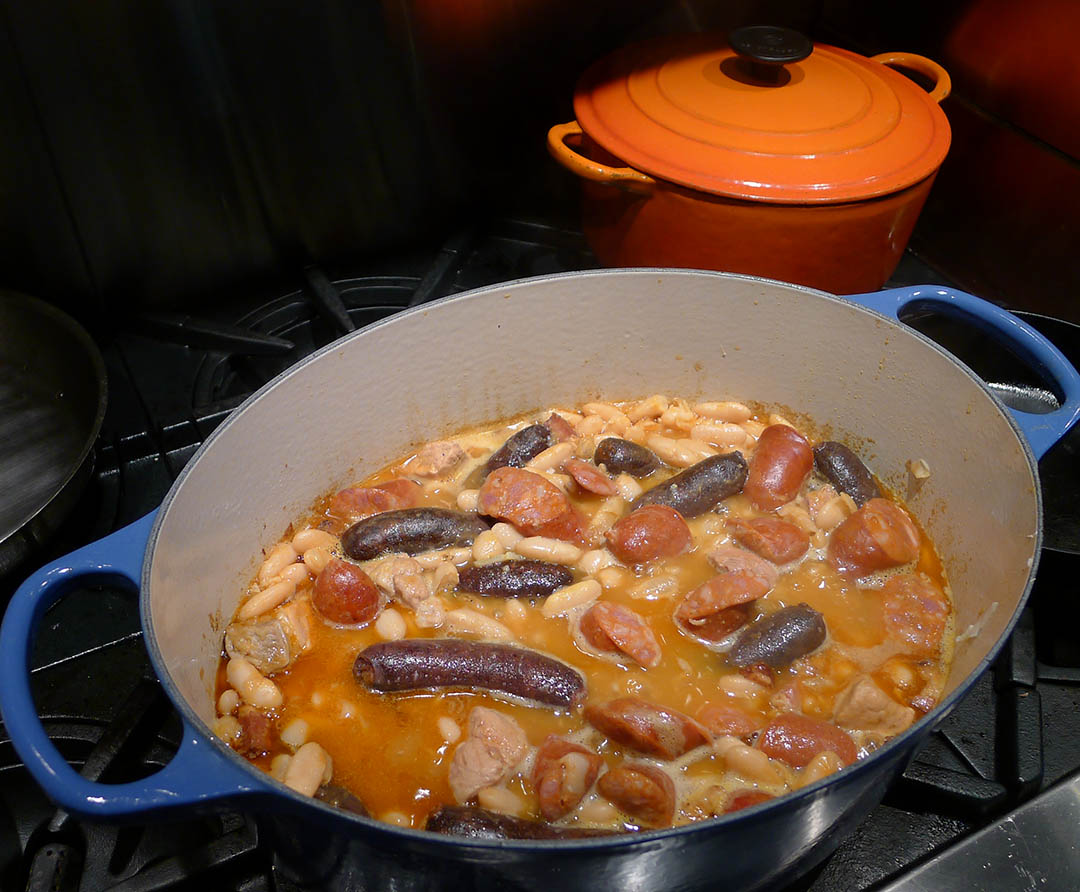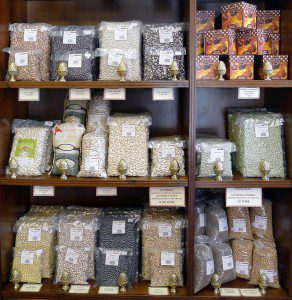
06 May HUNTING & GATHERING: THE RAIN IN SPAIN & FABADA
 Sorry Professor Higgins and Eliza Doolittle, the rain in Spain has absolutely nothing to do with the plain. It much prefers the hilly lands of the country’s northern coast.
Sorry Professor Higgins and Eliza Doolittle, the rain in Spain has absolutely nothing to do with the plain. It much prefers the hilly lands of the country’s northern coast.
Reminiscent of the Irish countryside, la Costa Verde, or the Green Coast, is a lush landscape of rolling hills, verdant pastures and craggy shoreline. Celebrated as one of the prettiest areas in Spain, beauty comes at a small price for the people who live there. It is often very, very wet.
For the duration of our entire journey along the Bay of Biscay from the charming capital of Galicia, Santiago de Compostela, through the mountainous provinces of Asturias and Cantabria to the lively seaside town of San Sebastian in Basque country, it misted, drizzled, sprinkled, showered, poured and pelted rain.
“Ah, but it brings luck” spouted a friendly barman in one town. It must have, I guess, because we grew to ignore our wet shoes and reveled in our lovely surroundings. Bliss was also discovered in many glasses of great Ribeiro and Alabariño, as well as on many plates of the delicious fare we fortified ourselves with along the way.
Every region of Spain has some specialty it celebrates. Naturally we tried to sample as many as we encountered: the tarta de Santiago, the famous almond tart from Santiago de Compostela that commemorates the apostle St. James; the freshly stewed octopus hoisted from bubbling pots in Galician market stalls and served on wooden plates with olive oil and paprika; the refreshing Asturian cider that is splashed into glasses by steady hands from three feet overhead; the pungent navy blue Cabrales cheese aged in the caves of the Picos de Europa; the mammoth grilled turbot that took over our entire table in Getaria; and the extraordinary array of Basque pintxos featuring freshly caught anchovies that line the tapas bars in San Sebastian.
Any trip across Spain is not only a journey through different regions, many of which still maintain their own distinct languages, it is inevitably a trip through history, as evidenced by the narrow medieval streets, ancient buildings featuring castle turrets and gargoyles, and by the signs of some purveyors who proudly proclaim continued business dating back several centuries. In Santiago de Compostela, where our parador hotel has housed travelers since the 1400’s, modern religious pilgrims arrived in droves to mark the end of their treks along the Camino de Santiago to the cathedral in the square, where they could be absolved of all their sins.
If the pageantry of pilgrims maintaining a tradition that dates back 1,000 years highlighted the passage of time, nearby caves with the prehistoric markings of our ancestors only amplified it. Northern Spain, like Southern France, is home to an extraordinary wealth of cave art, which records the existence of human beings in this part of the world as early as the last Ice Age.
Imagining early man, swaddled in animal skins and huddling for warmth around a small fire in a damp cave as reindeer roamed the icy terrain outside, silenced any complaint I had about the wet walk from the parking lot. It also made me very hungry.
Fabada, the rich fortifying bean stew, ubiquitous throughout Asturias and Cantabria, became a daily favorite. It appeared on every menu from the delicate deconstructed version we ate at the Casa Gerardo in the tiny town of Prendes to the pedestrian one we settled for in the high peak town of Fuente De. The very best bowl appeared on our table in the town of Cangas de Onis, near the Picos de Europa National Park at a spot called El Molin de la Pedrera, or The Old Stone Mill. Our chatty waitress, eager to practice her English, pronounced it “muy light.” I corrected her with a smile. No matter how small the portion, this is heavy fare that can sate even a ravenous caveman.
The bean, or faba, itself, is what makes the stew so prized. Large and white, with a delicate skin, creamy texture and buttery taste, it is a terrific balance to the stew’s other ingredients: chorizo, pork shoulder, fatback and morcilla, the exquisite blood sausage celebrated in the region. Eager to recreate the dish when I returned home, I brought a big bag of beans back with me in my suitcase, only to find them available at the store in NYC where I bought the sausages I used to recreate this recipe.
Despaña, in lower Manhattan, is a great source for all ingredients Spanish if you are in NY. La Tienda is the place to turn to if you want to order anything by mail.
Fabada Asturiana
Serves 8
2 lbs. dried faba beans, soaked overnight
2/3 cup slab bacon, cut into ½-inch dice
3/4 lb. boned pork ribs, cut into 1-inch dice
1 large Spanish onion, diced
2 cloves garlic, minced
2 bay leaves
Pinch of saffron
1 tsp sweet paprika
Fresh ground pepper
4 chorizos cut into 2-inch pieces
8 small morcilla sausages
Salt
• In a small skillet, cook the bacon until it has rendered much of its fat. Reserve.
• Sauté the onion slowly until it is transparent.
• Add pork rib meat and brown.
• Add garlic.
• Add soaked beans and cover with water.
• Add bay leaves, saffron, paprika and pepper.
• Simmer for an hour or more until the beans are almost soft.
• Add bacon, chorizo and morcilla and more water if you need to. Continue cooking until beans are soft.
• Add salt and adjust seasoning.
Serve with a “muy light” salad, such as frisée and sherry vinaigrette.



Portatiles
Posted at 13:47h, 11 SeptemberIt’s truly a nice and useful piece of info. I’m satisfied that you just
shared this helpful information with us. Please stay
us informed like this. Thank you for sharing.